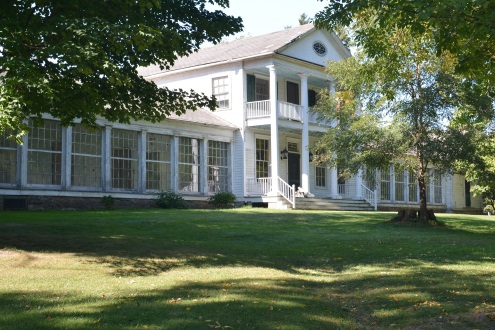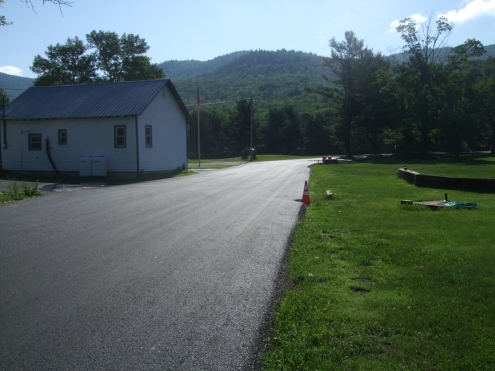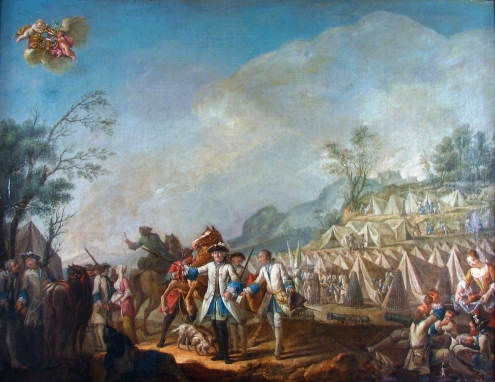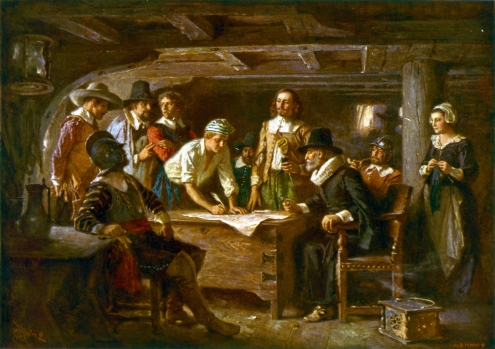April 23, 2016 is 400 years from what is believed to be William Shakespeare’s date of death. In celebration of this unique talent:
Henry V – Speech – Eve of Saint Crispin’s Day

News & Opinion About Huletts Landing, N.Y.
April 23, 2016 is 400 years from what is believed to be William Shakespeare’s date of death. In celebration of this unique talent:
Henry V – Speech – Eve of Saint Crispin’s Day
This morning’s Gospel reading is John 20:1–9:
On the first day of the week, Mary of Magdala came to the tomb early in the morning, while it was still dark, and saw the stone removed from the tomb. So she ran and went to Simon Peter and to the other disciple whom Jesus loved, and told them, “They have taken the Lord from the tomb, and we don’t know where they put him.”
So Peter and the other disciple went out and came to the tomb. They both ran, but the other disciple ran faster than Peter and arrived at the tomb first; he bent down and saw the burial cloths there, but did not go in. When Simon Peter arrived after him, he went into the tomb and saw the burial cloths there, and the cloth that had covered his head, not with the burial cloths but rolled up in a separate place. Then the other disciple also went in, the one who had arrived at the tomb first, and he saw and believed. For they did not yet understand the Scripture that he had to rise from the dead.
To begin the day: the Royal Choral Society: ‘Hallelujah Chorus’ from Handel’s Messiah
Taken from the Jerusalem Triptych
c. 1497-1500
The National Museum in Warsaw
Gdansk, Poland
Netherlandish or Northern German painter
(Click image to see larger version.)

Fort Ticonderoga’s Pavilion is located on the shore of Lake Champlain below the Fort.
A very historic building lies on the grounds of Fort Ticonderoga that many people don’t know anything about. Located below the Fort, on the shore of Lake Champlain, stands the Pavilion. It was built as a summer home in 1826 by William Ferris Pell. He and his family occupied it through the 1830s.
By 1840 the house had begun to be used as a hotel, its primary function through 1900. As a hotel the house welcomed travelers passing through Ticonderoga while traveling by steamboat on Lake George and Lake Champlain. The hotel is known to have accommodated such guests as Robert Todd Lincoln, son of President Abraham Lincoln; the prominent French & Indian War historian, Francis Parkman; and prolific Adirondack photographer, Seneca Ray Stoddard. When William Ferris Pell’s great-grandson, Stephen H.P. and his wife Sarah G.T. Pell began the restoration of Fort Ticonderoga in 1909, they simultaneously undertook the restoration of the Pavilion and used the house as a summer residence for many years. After Stephen Pell’s death in 1950 his son John occupied the house until 1987.
The design phase for Fort Ticonderoga’s Pavilion, is now underway thanks to a grant from the New York Council on the Arts and generous individual donor support. John G. Waite Associates, Architects PLLC, a leading consultant in the field of historic preservation architecture, has been hired to prepare schematic design and design development documents for the historic home located on Fort Ticonderoga property. The documents will allow Fort Ticonderoga to move forward with the stabilization and complete restoration of this nationally significant building as part of their overall site master plan.
Plans for the Pavilion’s reuse include meeting space, hospitality functions, administrative support, dining, and guest services. The Pavilion’s restoration is part of a larger multi-year capital initiative being undertaken by Fort Ticonderoga.
“Fort Ticonderoga is extremely pleased to begin this important project,” said Beth Hill, Fort Ticonderoga President and CEO. “As one of the earliest summer homes and hotels in the region, the Pavilion is considered one of the most important historic structures in the Adirondacks. The Pavilion is a critical link spanning nearly two centuries of Fort Ticonderoga’s history encompassing the stories of landmark preservation, the birth of American tourism, and monumental restoration.”
Although much of the Pavilion’s early fabric remains, the building has been altered over the years and today is in poor condition because of decades of little or no maintenance. Interior features have deteriorated along with elements of the building’s exterior. Without stabilization and rehabilitation work, the building would be in jeopardy of being lost, making this project vital and timely.
A team of architects, architectural historians, and building conservators from John G. Waite Associates carried out a thorough investigation of the Pavilion in 2013-2014, to document and understand the current state of the building and identify the various phases of the building’s evolution. Dendrochronology was conducted on timbers in the structure during that time and identified beams dating from the late 17th century, 18th century, and 19th century. The research provided the foundation for future plans of restoration and reuse.
“A sunny disposition is worth more than [a monetary] fortune. Young people should know that it can be cultivated; that the mind like the body can be moved from the shade into sunshine.”
Andrew Carnegie
BURGLAR’S LAST JOB
Hudson Falls Man Killed While Robbing House at Hague
Shot By Artist Harry Watrous
Frank Cardinal Fatally Wounded by Two Bullets from Colt Automatic—His Brother Escapes Uninjured But is Captured and Jailed.
Harry W. Watrous, a New York artist, at 2 o’clock Monday morning discovered Frank and Joseph Cardinal, of Hudson Falls, engaged in burglarizing his summer home at Hague and opened fire on them with a Colt Automatic revolver. Two bullets struck Frank Cardinal in the abdomen, inflicting wounds which caused his death in the Moses hospital in Ticonderoga at 3 o’clock in the afternoon. The brother jumped through a window and escaped. He was pursued by Sheriff Richard Bolton, and was captured at 10 a. m. and lodged in the county jail at Lake George.
Mr. and Mrs. Watrous occupied a room in the second story of the cottage and the latter was first awakened by the noise the men made in their operations. She aroused her husband, who took an electric flashlight and a revolver and went to investigate the cause of the noise. Entering the dining room, clad only in his night robe, Mr. Watrous flashed his light and its rays fell directly upon the crouching figure of a man. Not knowing whether the intruder was armed, Mr. Watrous fired at him and at the same instant his thumb slipped from the button on the flashlight, leaving the room in darkness. Again he flashed the light and saw what he thought might be a different man, so aimed a shot at him. The man fell to the floor with a groan and at the same time a crash of glass was heard as the other man plunged through a window in another room and fled in the darkness.
Warrensburg New
June 19, 1913

A “road closed” / detour sign was in place for three months as the Eichlerville bridge was worked on in 2015.
Since I’ve been writing here on the Huletts Current, I’ve gotten in the habit of recapping at the end of the year what I consider to be the top news story of Huletts Landing from the past year. This is sometimes obvious, sometimes it is not.
This year, the biggest “story,” in my opinion, was the rebuilding of the “Eichlerville” bridge which took a number of months, and the repaving of County Route 6. In other words, the bridge and roads took center stage in 2015. I realized I took the most pictures of those events during 2015, many of which I post here. While many things happened in Huletts during 2015, the work on the bridge and roads was indeed significant.
So for 2015, I’ve selected the the rebuilding of the “Eichlerville” bridge, and the repaving of County Route 6 (which were actually two different events but tremendously significant to travel throughout the community) as the: Top News Story of Huletts for 2015.
The abutments from the “old” bridge were in rough shape after over 100 years of use.

The new abutments were brought in individually and joined on site.

Great care was taken to protect the environment as the new bridge was constructed.

Work progressed slowly but methodically.

The cross pieces were brought in near the end.

Finally, the bridge had to be joined to the existing private road.

The “new” Eichlerville bridge as it looked upon completion.

Also in 2015, Washington County repaved County Route 6 right past the Huletts Post Office.

This work was significant and also much needed.
New Bridge and Roads: Top News Story of Huletts for 2015
I want to take this opportunity to wish everyone a very Merry Christmas and a happy and healthy holiday season.
Mary, Did You Know? – Peter Hollens

Image of the Fort Ticonderoga Museum’s newest acquisition, one of the very few surviving contemporary images of French regiments that saw service in North America.(Click image to see full-scale.)
Fort Ticonderoga is thrilled to announce the recent acquisition of an important painting of the French military on campaign from the mid-18th century. The work depicts a French regiment camped in hilly terrain of the Italian Piedmont during the final campaigns of the 1740-1748 War of Austrian Succession. This painting is an internationally significant addition to the museum’s collection and an important document of military and material culture during the Ancient Regime with a direct connection to the French soldiers that built and served at Fort Carillon (later named Ticonderoga) during the French and Indian War (1754-1763).
The campaign depicted in the painting involved French forces advancing into Northern Italy. These French troops suffered a shocking defeat at the hands of numerically inferior Piedmontese troops at the Battle of l’Assietta. The Marquis de Montcalm also served during the campaign depicted in the painting, where he was wounded during the battle, his final field command prior to his service in Canada. The painting represents the camp of the Royal Roussillon Regiment, identifiable by their uniforms which follow the January 19, 1747 regulations. This regiment later served and wore the same uniforms at Fort Carillon from 1756-1758, including the climactic battle on July 8, 1758, making this one of the very few surviving contemporary images of French regiments that saw service in North America.
This painting serves not only as a detailed glimpse into a French military encampment, but represents a campaign that may have served as a lesson for the Marquis de Montcalm of how a small, well-entrenched force could defeat a much larger army. The lopsided victory at l’Assietta in 1747 shares some striking similarities with the later battle at Ticonderoga in 1758, including the presence of Montcalm as well as four of the infantry regiments that had fought in Italy, one depicted in this painting.
“The intricate detail of the painting is a remarkable window into daily life in the French military,” said Fort Ticonderoga’s Curator Matthew Keagle. “It illustrates in full color many of the details of camp life depicted in the engravings of military manuals in the Fort Ticonderoga Museum’s library collection. The level of detail allows the identification of numerous examples of objects from soldiers’ muskets to powder horns to eating utensils that match examples recovered archeologically at Fort Ticonderoga.”
Fort Ticonderoga holds one of North America’s premier collections of 18th-century military material culture. This painting adds immensely to the museum’s holding of French material. Exhibits across the museum’s campus contain thousands of objects and tell thousands of stories, narrating the history of Fort Ticonderoga from the military culture of the 18th century to the reconstruction of the fort in the 20th century. The painting will be on display during the museum’s 2016 season in the Deborah Clarke Mars Education Center
Horses Drown in Lake George Waters
Geo. Potter of Bolton Takes Plunge with Team – Barely Escapes Death
On Monday afternoon, George Potter, a teamster of Bolton, had a very narrow escape from drowning, when the sleigh which he was driving broke through the ice and sank to the bottom, carrying the team with it.
Potter was drawing cement from Bolton to Three Brothers’ Island, the summer home of Mrs. Spencer Trask, and had about a 5,000 pound load on his sleigh. At the point where the accident occurred the ice was only six inches thick and this was not enough to support the sleigh.
The heavy load caused the sleigh to sink like lead and this pulled the horses down. They made frantic efforts to save themselves, but to no avail, for they soon sank out of sight.
Mr. Potter was also precipitated into the water, but quickly recovered himself and was on the ice. He turned to help the horses, but they had gone down in the meantime and being hitched to the heavily laden sleigh, never rose to the surface.
Outside of his icy dip, Mr. Potter is none the worse for his experience. The team was valued at about $300.
Glens Falls Star
January 19, 1911

‘Signing the Mayflower Compact 1620’, a painting by Jean Leon Gerome Ferris 1899.
Before they established their colony in Plymouth, the Mayflower Compact was signed aboard the Mayflower on November 11, 1620 by the Pilgrims. They used the Julian Calendar, which, at that time, was ten days behind the Gregorian Calendar. Signing the document were 41 of the ship’s 101 passengers, while the Mayflower was anchored in what is now Provincetown Harbor within the hook at the northern tip of Cape Cod. They had planned to settle in Virginia but had reached America farther north.
Mayflower Compact (Modern Version)
In the name of God, Amen. We, whose names are underwritten, the loyal subjects of our dread Sovereign Lord King James, by the Grace of God, of Great Britain, France, and Ireland, King, defender of the Faith, etc.
Having undertaken, for the Glory of God, and advancements of the Christian faith and honor of our King and Country, a voyage to plant the first colony in the Northern parts of Virginia, do by these presents, solemnly and mutually, in the presence of God, and one another, covenant and combine ourselves together into a civil body politic; for our better ordering, and preservation and furtherance of the ends aforesaid; and by virtue hereof to enact, constitute, and frame, such just and equal laws, ordinances, acts, constitutions, and offices, from time to time, as shall be thought most meet and convenient for the general good of the colony; unto which we promise all due submission and obedience.
In witness whereof we have hereunto subscribed our names at Cape Cod the 11th of November, in the year of the reign of our Sovereign Lord King James, of England, France, and Ireland, the eighteenth, and of Scotland the fifty-fourth, 1620.
Wishing you and yours a very happy Thanksgiving!
Update:
On PBS Thanksgiving Day at 8:00 pm EST (check your local listings)
The story of the Pilgrims – who they were, what drove them on – their searing first years in America and pivotal interactions with Native Americans – how they succeeded and how they failed – and how and why we have come to remember them as we do – is a tale far more harrowing and strange – and far more revealing – than the Thanksgiving myth we think we know.
From acclaimed filmmaker Ric Burns, The Pilgrims uncovers the riveting story of the men and women of the Mayflower – exploring the historic forces and personalities that motivated their crossing – and the harrowing events that unfolded in their crucial first decade in Massachusetts.
The Burns’ note (in your Seven Years Old Birthday post) about their DelNoce days reminded me of my days working for your grandfather, George H. Eichler, during the summers of 1962 and 1963 as a waiter including an additional two years as headwaiter and then my final year, the summer of 1966 (the year I graduated from Princeton University), as a bartender. We also lived in DelNoce during the summers of 1970 and 1971 when I ran the Casino and soda fountain for GHE.
One of those 60’s summers was indeed the summer that “The Mohican” ran aground and settled in “Bosom Bay” as its passengers got out and set up a party place at the old “Big Boat Dock” area, with sodas thanks to GHE.
He, who by the way, wore an all white suit which I had never seen before nor did I ever see again; worn ironically the night of the “Mohican landing” when the steamship’s buses from Schenectady didn’t make it over the mountain, thus necessitating the “Dads’ caravan” to transport the Mohican’s beached occupants over the mountain and down to the buses, at the bottom of County Route #6, on Route #22.
Jim Mettler
Huletts Landing
New York’s Lake George Steamboat Company recently commissioned API Services to laser scan the hull of the oldest boat in its fleet, the 107-year-old Mohican.
Visit: http://www.marinelink.com/news/historic-scanned-vessel400970.aspx

The Hulett Hotel on Lake George circa 1913-1915. (Click image to see full scale – large file 8.3 MB’s)
Excerpted from the Hulett Hotel Fire on Lake George
November 14, 1915, was a Sunday. The Glens Falls Times and Messenger reported that the night had been fair and slightly colder. The weather that morning was clear and cool. Sunday was considered a day of rest, and most people would have been attending morning church services. By mid morning, there were only two people on the grounds of the Hulett Hotel. They were the caretaker, Willis Foster, who was expecting a quiet day, and Mr. Adelbert Buckell, the brother of Henry W. Buckell, the former owner.
The day would soon change things forever. Willis Foster smelled the smoke first and then spotted the fire coming from the hotel’s roof-line near the main chimney. By the time he saw it, it was already a blazing inferno. Because it raged from the upper floors near the center of the building out toward the ends, it appeared to have started near the chimney. When Foster discovered it, it had reached such proportions that it was impossible to put out. It burned fast and quick; it burned hot. He and Adelbert Buckell were alone by all accounts. Upon discovering that the fire could not be brought under control, the shock must have been instantaneous. What greater regret could the lonely caretaker have felt than to see the historic structure go up in flames on his watch?
The conflagration was so great that it was spotted almost immediately from across the lake. The fire did not stop at the hotel, either, quickly jumping to three nearby cottages as well. The Ticonderoga Sentinel reported:
The small number of men who crossed the lake to assist [Willis Foster] could do but little more than stand idly by and watch the flames eat up the buildings. From the hotel the fire spread to the three nearest cottages, all of the buildings burning like tinder. There are twenty cottages in connection with the hotel and for a time it was feared that all or most of them might go up in smoke, but, fortunately, the fire was confined to the three nearest the hotel.
Imagine the poor caretaker, Foster, discovering the roaring inferno in a deserted, out-of-the-way place like Huletts Landing, with little immediate assistance from neighbors and no fire company to respond. No wonder men rowed from across the lake to help. Those neighbors from the lake’s opposite shore knew when they saw flames that their assistance would be needed.
Accounts are few and unclear, but one of the men present, either Foster or Buckell, galloped off on horseback to round up assistance throughout the hamlet. A nearby neighbor, Cora Phillips, was one of the first people to arrive after she saw the thick black smoke. What a scene it must have been, with neighbors rowing across the lake and either Foster or Buckell doing his best imitation of Paul Revere, riding through the town shouting for help. Anyone seeing the smoke or hearing the cries would have immediately stopped what he was doing and run to the fire. All the while, the conflagration ate more of the hotel, spewing black smoke and bright orange flames high into the air.
The fire worked its way out of the center of the second floor, and within a half an hour, the west end of the hotel was completely gone. Because the day was somewhat windy, the fire easily jumped to nearby cottages.
Soon, more neighbors arrived and formed a bucket brigade to stop the fire’s spread. They were fortunate that the wind died down and the fire was prevented from spreading to additional cottages.
Within only two hours, the fire had completely destroyed the Hulett Hotel and three nearby cottages. Charred cinders and ashes were all that were left of the hotel. People from throughout the landing and the town of Dresden had come to look for themselves. The brick fireplace, remnants of the scarred chimney and some building supports were all that remained.